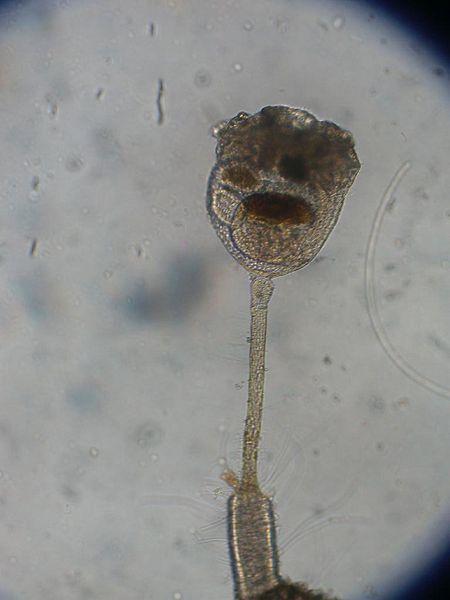Scientific classification of the Entoprocta (Entroprocta):
Country: Extinct (Fossil)
Conference: Homonymous Segmentals (Articulata)
Superphylum: Lophotrochozoa (Lophotrochozoa)
Phylum: Entoprocta (Entoprocta)
Characteristics of the spread:
Most species are colonial, and their members are known as "zooids", since they are not fully-independent animals. Zooids are typically 1 millimetre (0.039 in) long but ranging from 0.1 to 7 millimetres (0.0039 to 0.28 in) long.
Entoprocts are superficially like bryozoans (ectoproct)s, as both groups have a "crown" of tentacles whose cilia generate water currents that draw food particles towards the mouth. However, they have different feeding mechanisms and internal anatomy, and ectoprocts undergo a metamorphosis from larva to adult that destroys most of the larval tissues, and their colonies also have a founder zooid that is different from its "daughters".
The body of a mature entoproct zooid has a goblet-like structure with a calyx mounted on a relatively long stalk that attaches to a surface. The rim of the calyx bears a "crown" of 8 to 30 solid tentacles, which are extensions of the body wall. The base of the "crown" of tentacles is surrounded by a membrane that partially covers the tentacles when they retract. The mouth and anus lie on opposite sides of the atrium (space enclosed by the "crown" of tentacles), and both can be closed by sphincter muscles. The gut is U-shaped, curving down towards the base of the calyx, where it broadens to form the stomach. This is lined with a membrane consisting of a single layer of cells, each of which has multiple cilia.
The stalks of colonial species arise from shared attachment plates or from a network of stolons, tubes that run across a surface. In solitary species the stalk ends in a muscular sucker, or a flexible foot, or is cemented to a surface. The stalk is muscular and produces a characteristic nodding motion. In some species it is segmented. Some solitary species can move, either by creeping on the muscular foot or by somersaulting.
The body wall consists of the epidermis and an external cuticle,which consists mainly of criss-cross collagen fibers. The epidermis contains only a single layer of cells, each of which bears multiple cilia ("hairs") and microvilli (tiny "pleats") that penetrate through the cuticle.The stolons and stalks of colonial species have thicker cuticles, stiffened with chitin.
There is no coelom (internal fluid-filled cavity lined with peritoneum) and the other internal organs are embedded in connective tissue that lies between the stomach and the base of the "crown" of tentacles. The nervous system runs through the connective tissue and just below the epidermis, and is controlled by a pair of ganglia. Nerves run from these to the calyx, tentacles and stalk, and to sense organs in all these areas.
